Some time ago, I reached out on Instagram to see what Lot Hype licks I should learn. @idiophonic.harry recommended the 2017 Blue Devils Drum Break. What a cool lick! From super fast singles to probably the most difficult interp I’ve ever seen, there is a ton to unpack here. Let’s check it out!

First, let’s take a couple more looks at this 2017 Blue Devils Drum Break. Here’s a lot video.
And now let’s check them out on the field in their Encore Performance after winning DCI Finals.
Now it’s our turn to learn it. Grab the 2017 Blue Devils Drum Break sheet music from Lot Hype.
We are going to skip the first measure and jump to measure five. Take note that we are in 7/4 here, so there are seven quarter notes in each measure.

Your hands don’t get too much of a warm up as we jump right into sixtuplet singles at 190bpm! Stay relaxed on these, almost thinking of them as triple strokes (times 2) for each hand (offset by a 24th note, of course).
In fact, that is the best way to work on these. The check pattern is basically two counts of triplets on each hand. Start slow and gradually work up to 190bpm, staying as relaxed as possible. The two accents at the beginning help give you some momentum for the rest of the notes. To be honest, I can’t quite get them up to 190 yet, so good luck to you! It’s all about flicking those back fingers.

Next, we then go into a 16th note passage with inverted sticking and some really cool voicings. I find this around pattern particularly fun to play. The measure is finished off by a super fast roll on the shot drums. Be sure to adjust your fulcrum pressure when switching to the roll.

Measure 7 isn’t too bad. It gives you a great chance to show off the definition between your accents and inner beats. Enjoy this “easy” measure.
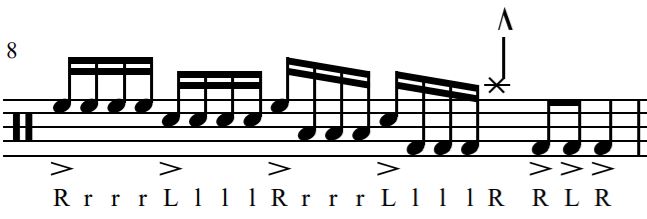
Now, we get to test out your quadruple stroke skills! Like with the sixtuplets in the first measure (these are even faster :/ ), use the momentum from the accents to help you get those notes out. BUT, be sure to use those back fingers so the last notes still have decent sound quality.
From here on out, it’s time to really work our interp skills. There are some crazy rhythms in the next few measures so hang on!
Let’s start with the half note triplets in measure nine. Beginning on count two, we have a standard half note triplet, but on count four, we add some double strokes. For the doubles, focus on the first notes of each hand. This way, you can keep the same wrist motion from triplet to triplet.
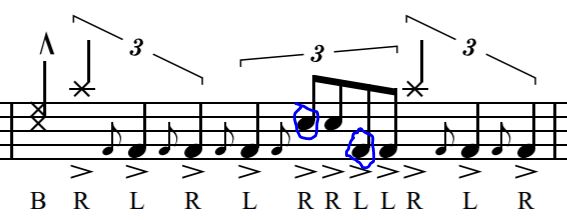
In measure ten, we switch to a half note fivelet with a paradiddle in the middle of it. First, let’s establish the speed of the fivelet. With your metronome on (of course), play a fivelet with L-L-R-R-L sticking. This breaks the paradiddle down to a check pattern. Make sure that every note is the same speed and your release is right with the click of the met.
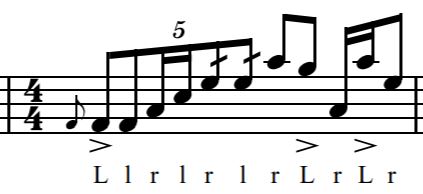
We you have the speed of the fivelet down, slowly add in the singles (herta) and then the diddles on the fourth and fifth partials. When comfortable, play the previous measure into this one so you get the transition.
Crazy interp alert!
Measure 11 is a little mind-bending. Part of me wants to think that BD just treated it as a listening exercise without worrying about lining up with the metronome, but of course that wasn’t the case. They are not ones to use short cuts.

Back to 7/4 time, we start the measure with a triplet. Next is a fivelet that spans three quarter notes. WTF?? How do you even begin to figure that out? To make it worse, the fivelet has both quarter and eighth notes. Unlike what we did previously, let’s turn the fivelet quarter notes into doubles like the rest of the fivelet. The sticking is now LL-RR-LL-RR-LL, giving us 10 notes over three counts.
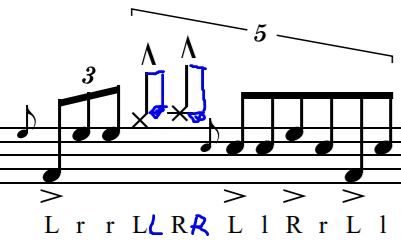
Now that we simplified the pattern, let’s figure out the speed of these notes. Before we math this out, let’s use some deductive reasoning and play a game I like to call faster or slower.
Faster or Slower?
We have 10 notes over three counts. If we continued the triplets of count one, we would only get 9 notes over the three counts, so we know the fivelet doubles are FASTER than the triplets. If we played 16th notes over the three counts, we would play, you guessed it, 12 notes. So we know that the doubles in our dotted half note fivelet are FASTER than triplets but SLOWER than 16th’s.
Confused yet? I don’t blame you. Stay with me though. Once you get comfortable with this, most other interpretations will seem so simple!
What helps is having at least one spot in the measure that you can use as a “check point” with your metronome. For this measure, I find the easiest spot is the third count. It’s pretty early in the fivelet, so this will let us know sooner than later if we are at the correct speed.
For our simplified version, LL-RR-LL-RR-LL, the metronome will click in between the two R’s (slightly closer to the second).
Between having this check point and the release, it’s just going to take trial and error. Turn on your metronome, selecting a 3/4 time signature with an accent on the downbeat, and practice our LL-RR-LL-RR-LL until you release right with the met’s accent. This will take many reps to get it consistently in time, but be persistent.
Once you find yourself lining up time and time again, add in the triplet on count one (change met to 4/4 time signature). To fully establish the triplet, I recommend doing 4 counts of L-R-R triplets then go into the measure (play a fifth triplet on count one of the second measure). Remember, the fivelet doubles are just barely faster than the triplets (10 notes in 3 counts instead of 9).
When this is lining up, take out the first two doubles and play the five-let as written L-R-LL-RR-LL.
Bear with me for a moment while I math this out. While playing the dotted half note fivelet, the metronome clicks once for every 3.333 eighth notes (10 notes/3 counts). This means that count 3 will happen just before the grace note of the left flam.
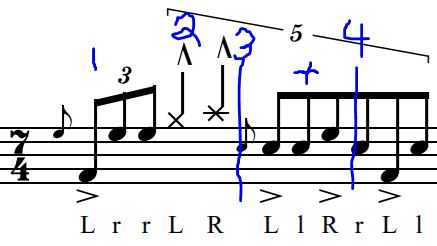
Let’s move on now.
We go back to a triplet feel, but with a left paradiddle starting on the 2nd partial of the triplet. Feel free to take out the paradiddle and play R-L-L as a check pattern. Remember, this triplet is the same speed as count one. When comfortable, add the paradiddle back in and practice these five counts with your metronome.

Guess what, we still aren’t done with this measure. We have another fivelet to figure out, this time over two counts. This is a little more straight forward, basically a tap roll with a cross and some sweeps. Of course, be sure to attack down for the sweeps to avoid hitting rims.
As far as speed, the fivelet will be slightly slower than the preceding triplet [5 notes vs 6 over two counts, or if you are thinking in terms of the doubles, 10 notes rather than 12]. After you get the fivelet roll lining up with your metronome, add in the triplet to get the transition.
Almost there! Measure 12 sticks with our half note fivelet, so that helps. This time though, we have a herta, actually a grandma, beginning on the 2nd partial. If you remove the herta, the check pattern is L-R-R-L-R. These notes, of course, are the same speed as the preceding five-let roll if you take out the drags.
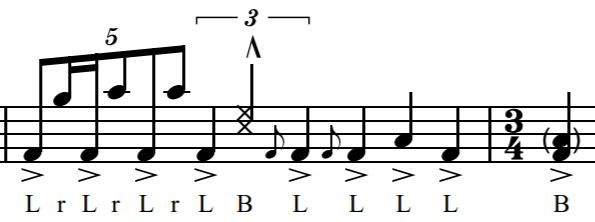
After that, we have a half note triplet and some quarter notes. Then, you’re done! Whew, that was rough! I don’t know about you, but my brain hurts.
Make sure to play this one way under tempo. It is very important to firmly establish each of these modulations, so they are perfectly in time. Once the muscle memory is ingrained in your hands, you can then start speeding up the tempo. This way, the interp you’ve worked so hard on will stick with you as the tempo increases.
Have fun with this one and don’t get discouraged. This is a tough lick! After spending the time to figure this one out, almost any other lick will look so straight forward!
If you like what you see and want to help out financially, consider contributing to my PATREON ACCOUNT.
Want to stay in touch? Fill out the form below and never miss a beat!

